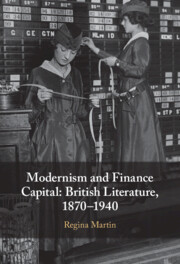Book contents
- Modernism and Finance Capital
- Modernism and Finance Capital
- Copyright page
- Dedication
- Contents
- Acknowledgments
- Introduction
- Part I From Victorian Character to Modernist Professional
- Chapter 1 Finance Capital and the Value Form of Character in Anthony Trollope’s Palliser Series
- Chapter 2 Detecting Modernist Form and the New Professional
- Chapter 3 Speculating Subjects
- Part II Finance Capital and the Economic and Cultural Turn toward London
- Part III Modernism, Affect, and the Rise of the Modern Corporation
- Conclusion
- Works Cited
- Index
Chapter 3 - Speculating Subjects
Finance Capital and the Professional Classes in Keynes and Woolf
from Part I - From Victorian Character to Modernist Professional
Published online by Cambridge University Press: 12 December 2024
- Modernism and Finance Capital
- Modernism and Finance Capital
- Copyright page
- Dedication
- Contents
- Acknowledgments
- Introduction
- Part I From Victorian Character to Modernist Professional
- Chapter 1 Finance Capital and the Value Form of Character in Anthony Trollope’s Palliser Series
- Chapter 2 Detecting Modernist Form and the New Professional
- Chapter 3 Speculating Subjects
- Part II Finance Capital and the Economic and Cultural Turn toward London
- Part III Modernism, Affect, and the Rise of the Modern Corporation
- Conclusion
- Works Cited
- Index
Summary
This chapter interprets Virginia Woolf’s The Waves through the economic theory of John Maynard Keynes. Keynes’s The General Theory of Employment, Interest, and Money waxes nostalgic for a world of industrial capital where people with good characters invest in respected businesses over the long term. Keynes blames the “great slump” on a system of financial speculation made possible by the modern corporation that encourages investors to anticipate and value the vacillations of popular opinion instead of sound business practices. This chapter argues that Woolf’s novel encodes the logic of financial speculation as described by Keynes in her depiction of characters who redefine themselves according to fluctuating social configurations. The resulting novelistic poetics constitute an aesthetic of volatility characteristic of high modernism that anticipates the emergence of affective intensity as the dominant value form of our own era of capitalism.
Keywords
- Type
- Chapter
- Information
- Modernism and Finance CapitalBritish Literature, 1870–1940, pp. 65 - 80Publisher: Cambridge University PressPrint publication year: 2024

